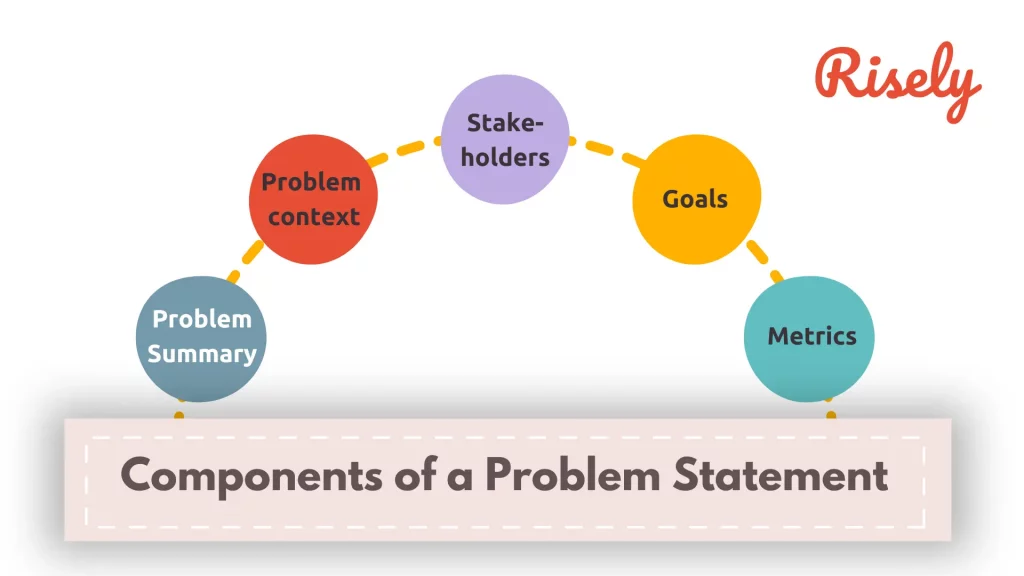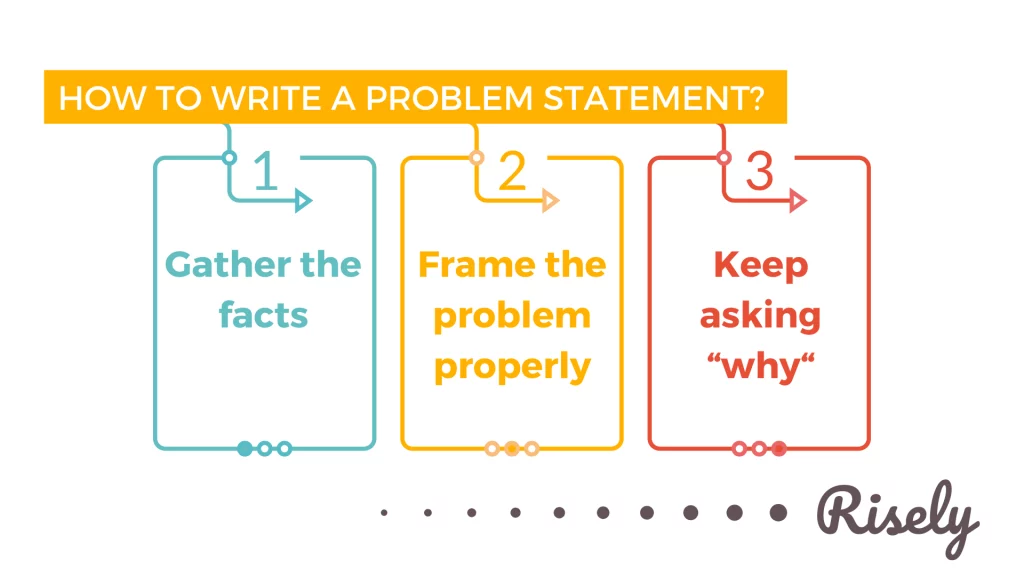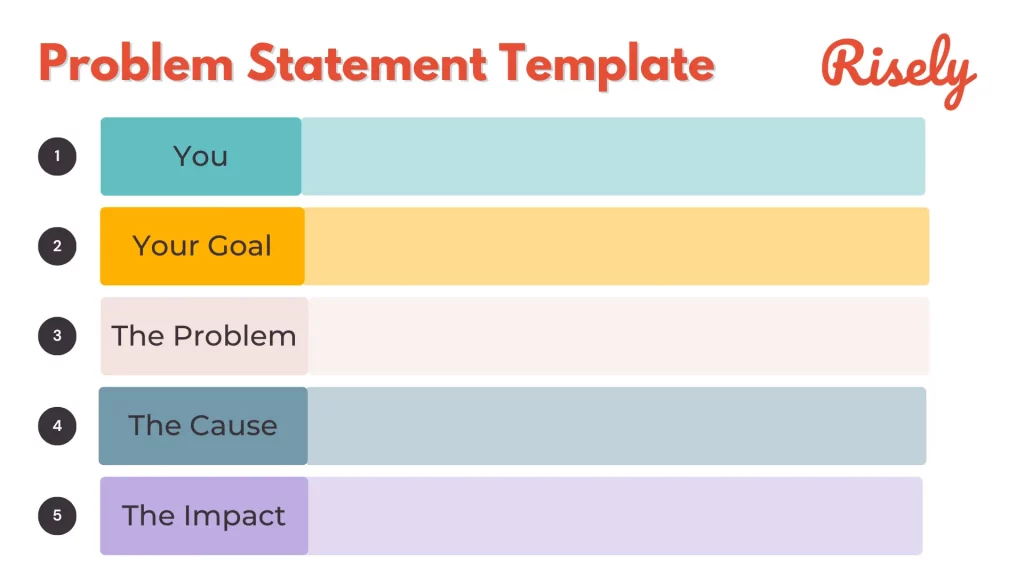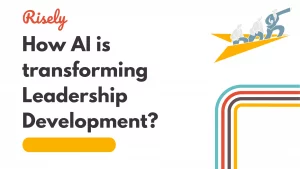What is a Problem Statement?
In the words of Alok Das, a senior change management professional, “a problem statement is the change maker’s secret tool.” Introducing a problem and its root cause is crucial for identifying and solving business challenges. A problem statement gives managers a clear definition of the issue, which helps them stay focused on the underlying problem rather than getting caught up in addressing symptoms. A good problem statement should be specific and measurable while providing context to explain why the issue is essential to solving it. By using well-crafted problem statements, managers can gain guidance and inspiration when developing their own for specific challenges.When can you Use a Problem Statement?
When faced with a business problem, it can be challenging to identify the root cause and determine the most effective solution. This is where problem statements come in handy. A good statement provides a clear and concise overview of the issue that needs to be addressed, making it easy for stakeholders to understand the problem and work towards finding a resolution. Some situations where problem statements can be super helpful include:- Project management: Managing a project begins with clearly identifying your goals and challenges. A problem statement is an excellent tool for project managers as it encapsulates all the aspects and provides a starting point for the team.
- Conflict resolution: Resolving conflicts when your entire team is already enmeshed sounds like a terrible headache. Problem statements can offer much-needed clarity in such scenarios.
- Strategic planning: Strategic planning begins with a clear understanding of your goals and the hurdles on the way – making evident the need for an effective problem statement to help managers.
- People management: People management challenges such as high turnover or hiring difficulties can be resolved systemically with the help of problem statements. HR professionals can use them to address issues that are hard to characterize in daily parlance.
- You are wondering where to get started
- You are unsure of the root cause of an issue
- Your team needs clarity (cross-functional projects, a new competitor, market changes, etc.)
Components of a Problem Statement

Component #1: Problem summary
Highlighting the issue at hand, a problem summary is essential to a well-structured problem statement. It clearly and concisely describes the problem while avoiding vague or general comments. The summary should also be relevant to the team’s objectives and goals, providing enough information for readers to understand the problem’s impact. A practical problem summary can help your stakeholders understand the need to address the issue while setting a foundation for identifying possible solutions.Component #2: Problem context
Effective problem-solving requires a clear understanding of the issue’s context. The problem context provides a comprehensive view of the problem, outlining its history, scope, and relevant factors that contribute to the present situation. By considering various internal and external influences that impact the problem, stakeholders can build an accurate understanding of the issue and develop practical solutions. Therefore, in writing good statements, you should define the problem in terms of its broader context so that all concerned parties can understand the underlying causes of its persistence.Component #3: Stakeholders
When crafting a problem statement, it’s essential to identify and define the stakeholders involved. These stakeholders can be internal or external, including employees, management, customers, suppliers, or the local community. You can prioritize solutions and meet its needs by clearly defining the stakeholders and their interests. Considering all relevant stakeholders is important to avoid overlooking potential solutions or exacerbating the problem by neglecting certain groups.Component #4: Goals
The goals component of a statement is a critical aspect that outlines the desired outcome. It provides you a clear direction for developing effective solutions and achieving results. By using SMART criteria– specific, measurable, achievable, relevant, and time-bound-, your goals can be well defined, making them easier to achieve. The goals should align with the organization’s objectives and consider any constraints or limitations that may impact achieving them. Clear goals help teams focus efforts on finding the most effective solution while ensuring that everyone involved works towards a common goal.Component #5: Metrics
Metrics are crucial to a problem statement as they help measure the problem’s scope and severity. They provide a clear and measurable way to track progress toward resolution while also quantifying the impact of the problem on stakeholders. For example, metrics such as cost savings, productivity improvements, or customer satisfaction ratings can be used to set specific goals and objectives for resolving the problem. By choosing metrics that align with organizational priorities, your problem-solving efforts can be focused on achieving the most impactful results. Ultimately, incorporating metrics into a statement helps you ensure that solutions are practical and meaningful for all stakeholders involved.5 Types of Problem Statements for Managers
#1: The Status Quo Problem Statement
Many teams face challenges that hinder productivity, customer satisfaction, or revenue growth. The status quo problem statement is a powerful tool for identifying areas of improvement and initiating change. This type of statement sets the context by describing the current state of the issue. It highlights the gap between the desired outcome and the current situation. By articulating what is not working well, managers can motivate their teams to search for solutions and improvements that can help them achieve better results.For example: Employees at our company are using outdated software to perform their daily tasks. This is causing inefficiencies in the workflow and leading to longer processing times, which is impacting our productivity and customer satisfaction
#2: The Destination Problem Statement
When setting goals, it is essential to have a clear understanding of the desired outcome. The Destination Problem Statement provides this clarity by defining specific objectives that need to be achieved. Whether aiming to increase sales or improve customer satisfaction, this statement helps identify the target audience, available resources, and potential obstacles. For example, if your company seeks to expand its market share in a new region, the Destination Problem Statement outlines the necessary steps to achieve this goal. You can develop effective strategies to reach the destination by clearly defining it.For example: Our organization aims to become a leader in sustainable business practices. However, we currently lack a comprehensive sustainability strategy and are struggling to achieve our sustainability goals.
#3: The Stakeholder Problem Statement
When addressing a problem, it’s essential to consider the perspectives of all parties involved. The Stakeholder Problem Statement provides a framework for doing just that. By identifying the needs and concerns of key stakeholders of the issue, this approach ensures that solutions satisfy their requirements while working towards the overall goal. In addition, this statement facilitates effective communication and collaboration among stakeholders, fostering a sense of shared purpose and joint ownership of the solution.For example: Our customers are experiencing long wait times and delays when trying to reach our customer service department. This is causing frustration and dissatisfaction, leading to a decline in customer retention and loyalty.
#4: The Solution-Focused Problem Statement
A solution-focused problem statement can e an effective approach when solving complex problems. Starting with acknowledging the current situation and shifting towards a positive direction by envisioning a desired outcome, this problem statement encourages brainstorming and creative thinking to find practical solutions. It helps break down barriers and inspire action, mainly when the problem seems overwhelming or complex. With a focus on solutions, this approach promotes progress and helps to achieve specific objectives.For example: Our sales team is struggling to close deals due to a lack of product knowledge and inadequate sales training. By providing additional training and resources to our sales team, we can increase their confidence and ability to close more deals.
#5: The Need-Gap Problem Statement
Launching a new product or service can be challenging, especially when there is significant competition in the market. The Need-Gap Statement effectively addresses this challenge by identifying the unmet needs of your people. This statement helps teams develop unique solutions that meet the specific requirements of their target audience. By conducting thorough research, teams can gain insight into the gaps in their processes and create a solution that caters to those needs.For example: Our target market is seeking a product that is affordable, eco-friendly, and effective. However, there are currently no products on the market that meet these criteria, creating a gap in the market that our company could potentially fill.
How to Write a Problem Statement?
Introducing a compelling problem statement is crucial to solving strategic problems efficiently. Stakeholders can develop a shared understanding and work towards a common goal by clearly defining the problem and its impact on the organization. However, crafting an effective problem statement requires careful consideration and a systematic approach. In this section, we will explore the steps involved in writing a comprehensive statement that reflects the root cause of the issue and identifies potential solutions.
Step 1: Gather the facts
Before crafting an effective problem statement, it’s vital to understand the problem clearly. How can you do that? Step 1 is all about that. Talk to all the relevant stakeholders, get in touch with your team, and bring all these inputs to the table before you move further. These crucial insights provide multiple perspectives and help identify the root cause of a problem. With a thorough understanding of the problem, you can craft a well-written statement that accurately defines the issue and provides direction for future solutions. There’s no right way to get this done. The best approach would involve authentic and open communication with every relevant person in the matter. You can also opt for surveys and interviews to gather more data in quantity or quality. At the end of this stage, all your basic questions about the context should be clear.Step 2: Frame the problem properly
Framing the problem accurately is essential to identifying practical solutions. By clearly defining the problem and its impact on stakeholders or the team and considering all underlying causes, you can begin to formulate an effective strategy. Moreover, a well-formed problem statement saves you from the trap of heuristics and biases that hurt your judgement. It’s essential not to make assumptions or jump to conclusions about the problem with proper analysis. You should also consider how the issue aligns with your organization’s goals and values. By framing the situation carefully, you can improve your chances of finding a solution that addresses it effectively while avoiding unnecessary complications.Step 3: Keep asking why (and check in on the progress)
Asking “why” repeatedly is a powerful technique for problem-solving. It allows you to delve deeper into the underlying causes of a problem instead of just addressing its symptoms. Using this approach, you can get to the root cause of the issue and create more effective solutions. Checking progress periodically is also important to stay on track and adjust your approach if necessary. Measuring specific metrics or outcomes is crucial to gauge success, and continuously refining your statement based on feedback and progress can lead to better results. Keep these points in mind when crafting your problem statement and approaching any challenges that may arise.Problem Statement Examples for Managers
Problem Statement Example for L&D Manager
A large software development company is experiencing a decline in employee productivity and an increase in employee turnover. The company values continuous learning and development.- Objectives: The L&D manager, Amy, aims to identify the root causes of decreased productivity and higher turnover rates and develop a plan to address these issues.
- Actions: Amy will conduct surveys and interviews with employees, review training and development programs, analyze performance data, and collaborate with HR to design targeted training interventions. She sums up her findings in a problem statement shared below.
“Our organization is experiencing declining productivity and increasing employee turnover. We aim to identify the causes, design effective learning and development interventions, and reduce turnover by 20% within the next fiscal year.”
This problem statement helps the L&D team understand what issues are hurting them. Amy also further clarifies how they will solve it, adding more surety on the future steps to take in a realistic and timely manner.Problem Statement Example for Healthcare Manager
A hospital’s emergency department struggles with long patient wait times, overcrowding, and staff burnout. Patient satisfaction scores are declining, and the hospital’s reputation is at risk.- Objectives: The manager, Jack, aims to reduce patient wait times, alleviate overcrowding, and improve staff morale and patient satisfaction.
- Actions: Jack will conduct process mapping, gather feedback from staff and patients, analyze historical data, and collaborate with the nursing and medical teams to implement changes in workflow and resource allocation. He crafts the following problem statement to get started.
“Our emergency department faces challenges related to patient wait times, overcrowding, and staff burnout. We aim to reduce patient wait times by 30%, decrease overcrowding, and improve patient and staff satisfaction scores within the next six months.”
With the help of this problem statement, Jack identifies the problems they are facing and up to what extent – therefore providing his team the clarity needed to plan the future course of action. He also specifies which areas are specifically facing issues.Problem Statement Example for Sales Manager
A regional sales team in a retail company consistently falls short of its sales targets. The company is experiencing a decline in revenue and market share.- Objectives: The sales manager, Rose, aims to identify the reasons behind the sales team’s underperformance and develop strategies to boost sales and revenue.
- Actions: Rose will analyze sales data, conduct sales performance reviews, and engage in one-on-one discussions with the sales team to understand their challenges. Additionally, they will collaborate with the marketing department to align strategies. To get started, Rose creates this problem statement.
“Our regional sales team is consistently falling short of sales targets, resulting in decreased revenue and market share. We aim to identify and address the underlying causes and implement strategies to increase sales by 15% within the next quarter.”
This problem statement by Rose highlights and clarifies the problem that is leading to a negative impact on the team. It identifies the root cause and also starts the process of realistic goal-setting with the team.Problem Statement Example for IT Project Manager
A software development project is consistently missing project deadlines and the quality of the delivered software is subpar. This negatively impacts client satisfaction and causes financial losses for the IT company.- Objectives: The IT project manager, Andrew, aims to identify the root causes of missed deadlines and poor software quality and implement strategies to ensure project timelines are met and software quality is improved.
- Actions: Andrew will conduct a project review, analyze historical project data, perform code reviews, evaluate testing processes, and collaborate with the development and QA teams to implement better project management practices. Finally, Andrew sums up the problem statement as follows.
“Our software development projects are consistently missing deadlines and delivering subpar quality software. Our aim is to identify the causes, optimize project management processes, improve software quality, and ensure projects are completed on time, meeting client and user expectations.”
In Andrew’s final problem statement, we can see him listing the issues that the team is facing. He talks about the next steps, i.e., identifying why it is happening and what actions to take for improvement. In this process, he also ensures that their priorities are outlined.Problem Statements Template for Managers
Writing problem statements is a very effective tool for managers. But sometimes, it can be tricky too. Worry not; we are here to help you out. As we noted, writing a statement involves three steps. It starts with information gathering and building the context in which the problem exists. Further, you also need to keep an eye on the changes as they happen and keep adapting. Based on this process, you will come up with five key aspects:- Your/ your team’s identity
- Your goals
- The hurdles on the way
- Why those issues are arising
- How are those issues impacting you

Leadership Problem Statements Examples
Team CommunicationProblem Statement: “Communication breakdowns within our team are leading to misunderstandings, missed deadlines, and decreased collaboration. We need to establish efficient communication channels and protocols to enhance team coordination and project outcomes.” Team Skill Development
Problem Statement: “The skill gap within our team is affecting our ability to deliver high-quality results. We must implement a structured skill development program to upskill team members and align their capabilities with project requirements.” Team Motivation and Engagement
Problem Statement: “Dwindling team motivation and engagement levels are impacting overall enthusiasm and creativity. We must develop initiatives that foster a positive team culture, boost morale, and inspire innovative thinking.” Delegation and Workload Balance
Problem Statement: “Uneven distribution of tasks and responsibilities is leading to burnout for some team members, while others have underutilized skills. We need to refine our delegation process to ensure a balanced workload and promote individual growth.” Team Diversity and Inclusion
Problem Statement: “Lack of diversity and inclusion initiatives within our team can limit perspectives and hinder creativity. We need to cultivate a diverse and inclusive environment that values different backgrounds and encourages open dialogue.” Succession Planning
Problem Statement: “The absence of a succession plan poses a risk to our team’s stability and continuity. We need to identify and groom potential leaders within the team to ensure a smooth transition and sustained performance.”
To sum up
A good problem statement can be one of the most effective resources for a manager. With the help of a problem statement, leaders can visualize long-term solutions for the issues that constantly bug their teams. This blog has provided examples of problem statements and a free template to achieve these remarkable results with your team, too. So, start today and build your team’s success step by step.Sharpen your problem-solving skills to unleash your true potential.
Become the manager you have always wanted to be – test your problem-solving skills and defeat hidden issues.






